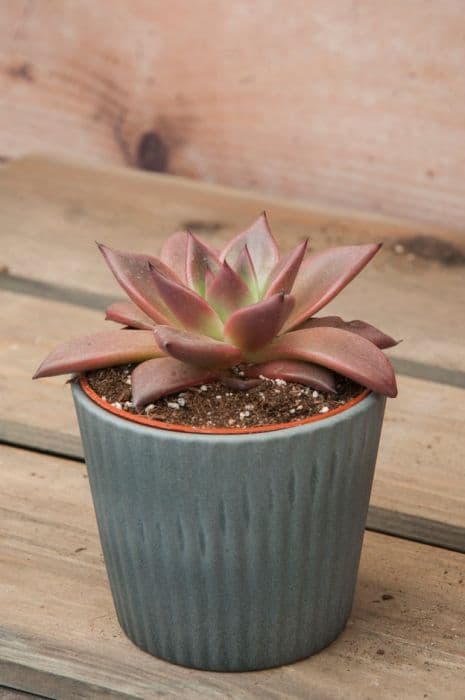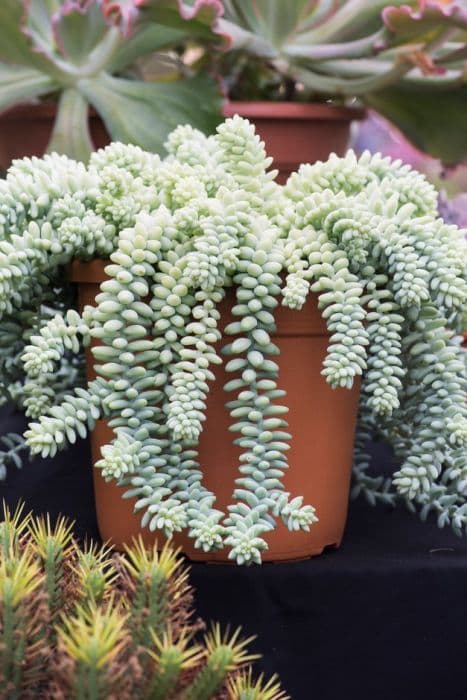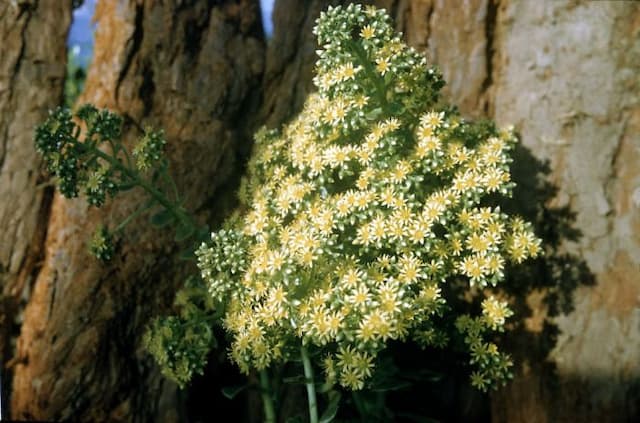Velvet Leaf Kalanchoe beharensis











ABOUT
The Elephant's Ear Kalanchoe is a distinctive plant with an attractive and unusual appearance. This plant is characterized by its fleshy, triangle-shaped leaves that have a velvety texture and gray-green color. The leaves are often covered with a fine fuzz that gives them a soft, matte look. The edges of the leaves are crinkly or scalloped, frequently with a brownish or reddish tinge that contrasts nicely against the softer color of the leaf. Furthermore, the branching pattern is irregular, with stems that can appear slightly twisted or gnarled, adding to its unique visual appeal. The overall silhouette of the Elephant's Ear Kalanchoe is quite bold and architectural, making it a popular choice for those looking to add a touch of exotic drama to their plant collection.
About this plant
 Names
NamesFamily
Crassulaceae
Synonyms
Elephant's Ear Kalanchoe, Velvet Leaf, Felt Bush, Velvet Elephant Ear
Common names
Kalanchoe beharensis
 Toxicity
ToxicityTo humans
Elephant's Ear (Kalanchoe beharensis) is considered to have low toxicity for humans. However, ingestion of this plant may still cause mild symptoms. The most common symptoms if ingested may include nausea, vomiting, and diarrhea. Generally, the consequences are not severe, but it is advisable to avoid ingesting any part of the plant.
To pets
Elephant's Ear (Kalanchoe beharensis) is toxic to pets, particularly cats and dogs. If ingested, it can cause symptoms such as vomiting, diarrhea, and in rare cases, an abnormal heart rhythm. The toxic compounds in the plant are called bufadienolides, which are cardiac glycoside toxins that can interfere with the electrolyte balance within the heart muscle. It is important to keep this plant out of reach of pets and seek veterinary care if any part of the plant has been ingested.
 Characteristics
CharacteristicsLife cycle
Perennials
Foliage type
Evergreen
Color of leaves
Olive-green
Flower color
Yellow-green
Height
3-5 feet (0.91-1.52 meters)
Spread
2-4 feet (0.61-1.22 meters)
Plant type
Succulent
Hardiness zones
9
Native area
Madagascar
Benefits
 General Benefits
General Benefits- Easy to Care For: Kalanchoe beharensis, commonly known as Velvet Leaf, is low-maintenance and can thrive with minimal attention, making it ideal for busy or novice gardeners.
- Drought Tolerant: Its succulent leaves allow it to store water, enabling it to withstand periods of drought, which is beneficial in arid climates or for water-wise gardening.
- Ornamental Appeal: With its distinctive felted leaves and unique growth habit, Velvet Leaf is an eye-catching plant that adds visual interest to any collection or landscape.
- Textural Contrast: The fuzzy leaves offer a unique texture that contrasts well with other plants, enhancing the overall aesthetic of a garden or indoor plant arrangement.
- Pest Resistant: Velvet Leaf is relatively resistant to pests, which reduces the need for chemical pesticides, contributing to a more organic gardening approach.
- Long-Lived: As a slow-growing plant, Velvet Leaf has a lengthy lifespan which means it can be enjoyed for many years with proper care.
- Propagation Ease: It can be easily propagated from leaf cuttings or offsets, making it simple to expand your collection or share with friends.
 Medical Properties
Medical PropertiesThis plant is not used for medical purposes.
 Air-purifying Qualities
Air-purifying QualitiesThis plant is not specifically known for air purifying qualities.
 Other Uses
Other Uses- Kalanchoe beharensis, commonly known as Velvet Leaf, can be used as a natural insect repellent due to certain compounds in its leaves that are unappealing to bugs.
- Due to its unique and striking appearance, Velvet Leaf is often used in themed gardens to create a visual texture contrast alongside other plants.
- The plant is sometimes integrated into education programs at botanical gardens to teach about succulent plant care and xeriscaping principles.
- Velvet Leaf's thick, fleshy leaves can be used in floral arrangements to add an exotic and durable greenery element that lasts longer than traditional leaves.
- In areas prone to erosion, Velvet Leaf can stabilize soil with its extensive root system while requiring minimal water.
- Its textural leaves can be used for artistic purposes, like leaf-casting, to create unique patterns and designs in cast concrete or plaster works.
- Some people practice leaf-cutting art on Velvet Leaf's large foliage, carving intricate designs directly onto the surface of its leaves.
- As an ornamental feature, Velvet Leaf can be grown in hanging baskets where its triangular leaves can cascade creating an aesthetic display.
- In regions where the climate is suitable, Velvet Leaf can sometimes be used as a living privacy screen due to its dense and shrubby growth habit.
- Velvet Leaf can function as a natural acoustic barrier when planted densely, as its thick leaves can absorb sound to reduce noise pollution in urban gardens.
Interesting Facts
 Feng Shui
Feng ShuiThe Elephant's Ear Kalanchoe is not used in Feng Shui practice.
 Zodiac Sign Compitability
Zodiac Sign CompitabilityThe Elephant's Ear Kalanchoe is not used in astrology practice.
 Plant Symbolism
Plant Symbolism- Persistence and Renewal: Kalanchoe beharensis, commonly known as Elephant's Ear Kalanchoe, often symbolizes persistence and renewal due to its ability to withstand periods of neglect and still bloom annually with the proper care.
- Endurance and Longevity: This plant's succulent nature and its capacity to store water in its leaves allow it to survive in harsh conditions, making it a symbol of endurance and longevity.
- Love and Devotion: In some cultures, giving a Kalanchoe beharensis as a gift can be seen as a gesture of love and devotion, as the plant's long-lasting blooms reflect these enduring emotions.
 Water
WaterThe Elephant's Ear Kalanchoe should be watered thoroughly when the soil feels dry to the touch, which may equate to once every week or two, depending on environmental conditions. Ensure that the pot has good drainage to prevent water from sitting at the bottom, which can lead to root rot. During the active growing season in spring and summer, water with approximately 8-16 ounces of water, but reduce the frequency in the fall and winter when the plant's growth slows. Always check the soil moisture level before watering to avoid overwatering this succulent plant.
 Light
LightElephant's Ear Kalanchoe thrives in bright, indirect light and can tolerate some direct sunlight, especially in the cooler morning hours. However, it should be protected from harsh afternoon sunlight to prevent leaf scorching. The best spot for this plant would be near an east or west-facing window with some shading or filtering to prevent intense sun exposure.
 Temperature
TemperatureElephant's Ear Kalanchoe prefers warm temperatures between 60 to 85 degrees Fahrenheit. It can survive minor dips down to about 50 degrees Fahrenheit, but temperatures below this can cause harm to the plant. Be sure to keep the plant in an environment within this ideal temperature range and protect it from drafts and extreme temperature changes.
 Pruning
PruningPrune Elephant's Ear Kalanchoe to maintain its shape and size, as well as to remove any dead or damaged leaves. Pruning is best done in the spring or early summer, before the plant's growth period. This plant does not require frequent pruning; doing so once a year or when needed should suffice.
 Cleaning
CleaningAs needed
 Soil
SoilElephant's Ear plant thrives best in a well-draining cactus or succulent soil mix with a pH between 5.5 and 6.5. A recommended soil mixture would contain equal parts of a standard potting mix, coarse sand, and perlite or pumice to ensure good drainage and aeration.
 Repotting
RepottingElephant's Ear should be repotted every two to three years or when it outgrows its pot. It's important to use a slightly larger pot and fresh soil mix to encourage continued growth and prevent root bounding.
 Humidity & Misting
Humidity & MistingElephant's Ear prefers average room humidity levels, generally between 40% and 60%. It does not require high humidity and can tolerate drier air typical of indoor environments.
 Suitable locations
Suitable locationsIndoor
Place Elephant's Ear in bright, indirect light and water sparingly.
Outdoor
Grow Elephant's Ear in partial shade, protect from frost.
Hardiness zone
9-11 USDA
 Life cycle
Life cycleThe life of Kalanchoe beharensis, commonly known as Velvet Leaf or Felt Bush, begins with germination, where the succulent's small seeds sprout in warm, well-draining soil with adequate moisture. Following germination, the seedling stage involves initial leaf development and root establishment, where the plant's characteristic velvety, triangular leaves begin to form. As it enters the vegetative growth stage, the Felt Bush experiences rapid leaf and stem growth, storing water in fleshy tissues to withstand drought. In maturity, the plant reaches sexual reproduction, developing inflorescences that bear small, greenish-yellow flowers, typically blooming in the spring. After pollination, which can be facilitated by insects, the flowers produce seed capsules containing numerous tiny seeds, thereby completing the reproductive cycle. Lastly, as a perennial, the Felt Bush may continue to grow and reproduce for several years, with individual plants often living for over five years under favorable conditions.
 Propogation
PropogationPropogation time
Spring-Early Summer
Kalanchoe beharensis, commonly known as "Felt Plant" or "Velvet Leaf," is often propagated through leaf cuttings. The most popular method for propagating this succulent involves taking a healthy leaf from the plant, allowing the cut edge to callous over for a few days to prevent rotting. Once calloused, the leaf is placed on top of a well-draining soil mix and lightly pressed into the surface. The pot should be placed in a warm spot with indirect light and the soil should be kept slightly moist. Small roots and new shoots usually begin to develop in a few weeks. It is important to avoid overwatering during this period, as too much moisture can lead to fungal diseases or rot.








![Takeshima stonecrop [Atlantis]](/_next/image?url=https%3A%2F%2Fplants-admin.emdemapps.com%2Fimages%2Fplants%2F%2Fimages%2F604b5470cdde2.png&w=640&q=75)
